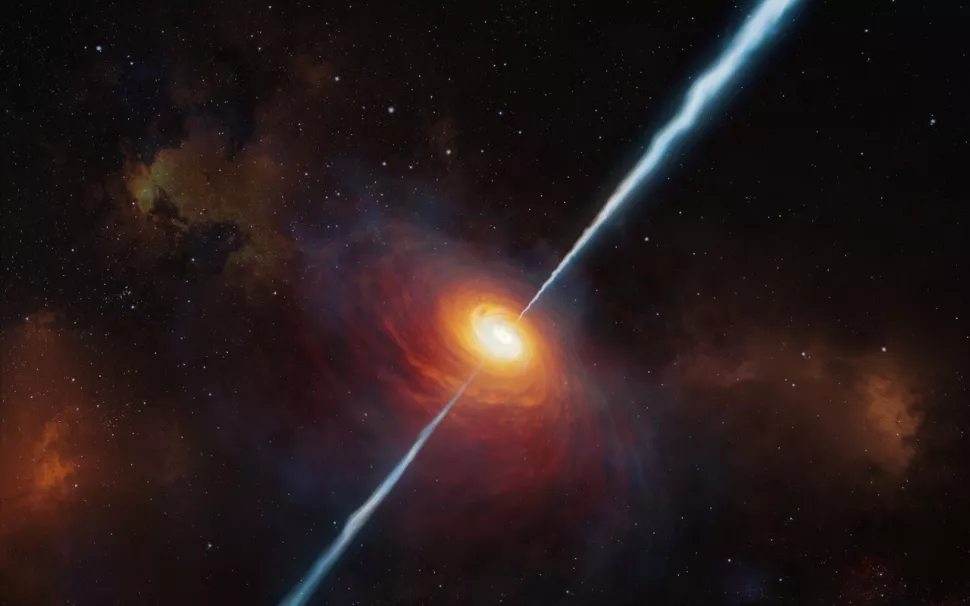A Rare Black Hole with a Mass of One Billion Suns Might Challenge Our Understanding of Galaxy Formation
The discovery of a hidden primordial black hole, which formed just 750 million years after the Big Bang, suggests that it may be the ‘tip of the iceberg’ of the cosmic monsters hiding in the early universe.
A newly discovered supermassive black hole from the early universe has left astronomers puzzled as it suggests the presence of thousands of similar objects during that time, which is more than previously estimated.
The black hole in question has a mass of approximately 1 billion times that of the sun, and was discovered at the center of the galaxy COS-87259, which was formed just 750 million years after the Big Bang. The observation was made by the Atacama Large Millimeter Array (ALMA), a radio observatory in Chile, which captured the image of the ancient galaxy in an area of the sky less than 10 times the size of the full moon.

The black hole was obscured by a cloud of turbulent stardust, but ALMA was able to observe it as it consumed part of its orbiting accretion disk and emitted the remaining matter in a jet traveling close to the speed of light. The black hole is in an intermediate stage of growth, exhibiting characteristics of both a dusty, star-forming galaxy and a quasar – an enormous, brightly glowing black hole.
The scientists propose that there could be thousands of similarly enormous black holes concealed within the foggy atmosphere of the early universe. Their findings were published on February 24th in the journal Monthly Notices of The Royal Astronomical Society.
Ryan Endsley, the lead author of the study and an astronomer at the University of Texas, Austin, stated that the existence of about 15 early luminous quasars from the same era as COS-87259 was a significant hurdle for extragalactic astronomy because of the brief period available for such a massive black hole to grow since the Big Bang. He added that if the discovery of the rare supermassive black hole suggests that very early billion-solar-mass black holes are much more prevalent than previously believed, it would worsen the problem further.
A supermassive mystery
Black holes come into existence when massive stars collapse, and they grow by consuming gas, dust, stars, and other black holes in the galaxies they inhabit. As they grow bigger, the material spiraling into their event horizons heats up due to friction, and they turn into quasars, shedding their gaseous cocoons with bursts of light that are trillions of times more luminous than the brightest stars. The further scientists look into the universe, the further back in time they see because of the fixed speed of light through the vacuum of space.
The earliest simulations of the universe suggest that clouds of cold gas may have condensed into giant stars that rapidly collapsed to create black holes, which merged with others to seed supermassive black holes throughout the cosmos. However, the creation of so many supermassive black holes in the early universe remains a mystery, especially if they numbered in the thousands when the universe was only 5% of its current age.
The easiest black holes to spot are the big, bright quasars, but they are likely just the tip of the iceberg. The recent discovery of six massive galaxies that were so massive they were in tension with 99% of cosmological models suggests a hole in our understanding of galaxy formation in the early universe. One possible explanation for the frenzied activity and quantity of the dense starburst clouds where the earliest black holes spawned.
In April 2022, the discovery of another rapidly growing black hole called GNz7q showed that the galaxy was forming stars 1,600 times faster than the Milky Way does today. COS-87259 forms stars at a slightly slower rate than GNz7q, yet its black hole is 20 times as massive and bright. The discovery of both COS-87259 and GNz7q raises questions about the understanding of very early supermassive black hole growth.
Do not forget to share your opinion with us to provide you with the best posts !





Asking questions are actually nice thing if you are not understanding something completely, but this paragraph gives good understanding even.
Hey! Would you mind if I share your blog with my twitter
group? There’s a lot of folks that I think would really appreciate your content.
Please let me know. Many thanks